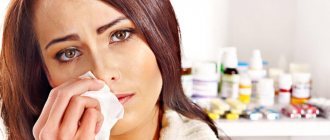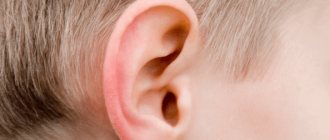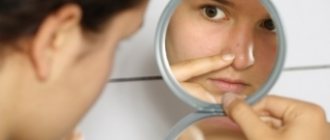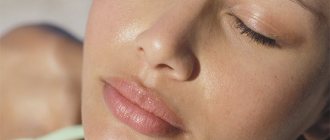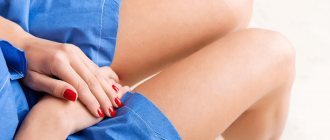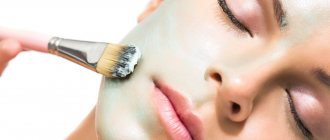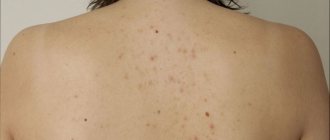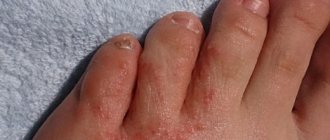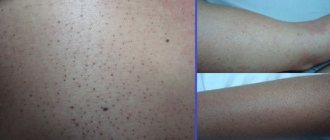Child has blackheads
– where does it come from, what does it mean, what measures to take?! This panic question is often asked on various women's forums by frightened mothers. But there is no reason to panic. Childhood acne is a fairly common phenomenon and can be easily eliminated.
Acne in newborns
30% of newborn babies aged from 3 days to 5-6 months develop white or black dots, often convex, on the nose and cheeks. Pediatricians associate this with hormonal changes occurring in the child’s body. As a rule, such acne goes away on its own with proper care. Sometimes the reason is nutrition. Perhaps the formula needs to be changed or the nursing mother needs to watch her diet.
Acne in elementary school children
Large black dots most often appear on the nose, forehead and chin in children 8-10 years old. There is no need to be afraid; today's schoolchildren grow up very early indeed. These are the first manifestations of puberty. You should start teaching your child to take care of his skin, as described below. Again, monitor your child’s nutrition.
How to treat baby acne
To get rid of blackheads on your baby’s face, it is recommended to follow all hygiene procedures, especially in the summer. Baths with string, chamomile, and celandine have a good effect. The child's face can be wiped with salicylic acid diluted with water. Sometimes after a bath, when the skin has steamed, blackheads become raised and can be easily removed with a towel or napkin. In this case, it is important not to get infected. Treat the remaining hole with an antiseptic. If inflammation could not be avoided and an abscess with a red rim and a white or yellow tip appears, lubricate it with fucorcin or brilliant green.
For older children, in addition to all of the above procedures, you can use more aggressive cosmetics to care for teenage problem skin. The most gentle and effective of them is sinerite. Masks made from white cosmetic clay also perfectly cleanse the skin of blackheads. You can buy it in powder at almost any pharmacy, it is inexpensive. For very oily skin, clay should be diluted not with water, but with salicylic acid or tonic.
The appearance of blackheads in adults is a completely common and familiar phenomenon. But if the same defects begin to appear in a child, this can raise a lot of questions and even some bewilderment. It is generally accepted that a child’s skin is perfectly clean, and therefore the appearance of black spots on it is not entirely explainable at first glance. Some mothers don’t even quite understand how to react to such a phenomenon in their baby.
The likelihood of acne increases during adolescence. For some children this is a big problem. But before you do anything, you need to clearly understand what the nature of blackheads in children is.
Pimples on the nose in a 6 year old child – All about Health
Baby acne or pimples in a child aged 4 to 6 years can really bother quite a few parents Baby acne at this age is a very common, but short-term phenomenon It will disappear without any medical help In the end, the skin of a newborn should be smooth and clear But if you notice pimples on your baby's cheeks, forehead, chin or even back, don't worry.
Approximately 20 percent of all children have experienced neonatal acne at various short periods of time at the age of 4, 5 or 6. Experts do not know exactly what causes this type of acne, but there are suggestions that it was caused by stimulation of the baby's sebaceous glands.
Currently, experts and researchers in the field say that acne in a child of this age may occur due to an inflammatory response to yeast Malaysia on the skin.
The most common types of acne in children are papules and pustules. Papules are small, solid, round red bumps that rise from the skin and look like a red pimple. Pustules or whiteheads are small bumps of skin or a pimple in which pus has formed.
Most children develop pimples in and around the face, including the cheeks and sometimes the area on the scalp Most lesions that develop on a child's face will clear up spontaneously without treatment within a four-month period of time. In many cases, a child's acne will clear up within a few weeks. .
Milia
Milia, or water pimples, are tiny white bumps that appear on the face, including the area of the nose, cheeks, or chin, most often in children between the ages of 4 and 6. In some cases, milia may also appear on the upper body, and also on your baby's arms and legs.
The most distinct difference between baby acne and milia is the color of the bumps. Baby acne is characterized by small red bumps, milia is characterized by tiny white bumps.
Although this child's skin condition can develop at any age, it usually develops during the preschool years of 5 to 6 years. More than 50 percent of all children of different ages have experienced the development of milia in the short term.
Milia is also more common in children born and living in warm climates Milia and pimples on the face and butt are also associated with sweat caused by clothing or fever This skin condition develops in children because tiny pimples are formed as a result of the baby's skin's sebaceous glands not working properly .
Although you may be concerned about the sudden development of pimples or milia in your child, remember that such inflammations usually do not develop for long, being present on the skin for no more than a month and most often disappear within one week. In most cases, milia disappears within a few weeks without any - or treatment Sometimes milia infects a child during the first three months of life.
The appearance of acne on the nose in children can be associated with various factors. These include various pathologies, changes in the balance of hormones in the body, and insufficient skin care. To cope with the disorder, you need to contact your pediatrician in time.
The specialist will examine the baby and, if necessary, prescribe additional tests. This will help deal with the problem and avoid its occurrence later.
What does it come from?
The main causes of problems include the following:
- Prickly heat. The cause of a small rash in a child may be exposure to high temperatures. That is why the problem is typical for the hot season.
- Allergic reactions. This disorder is accompanied by the formation of red rashes. They appear suddenly and often provoke a feeling of itching.
- Vaccination. Sometimes acne may appear after vaccination. Such a reaction should be a reason to consult a doctor.
- Influence of external factors. Acne on a child's face can occur under the influence of frost, wind, and ultraviolet radiation. All these factors have a negative impact on the baby's sensitive skin.
- Insufficient skin care. Young children's skin is highly sensitive. If it is contaminated, there is a risk of pustular rashes appearing.
- Insect bites. In some children, inflamed pimples are the result of insect bites. In addition to the nose, they can affect other areas of the body. Often there is a pronounced itching sensation.
- Acne of newborns. The cause of this problem is the increased content of hormones that are transmitted to the child from the mother.
- Puberty period. The appearance of acne during adolescence is associated with changes in the balance of hormones. During this period, the amount of male sex hormones increases. After the situation stabilizes, acne goes away.
Source: //womaninred.ru/pryshhi-na-nosu-u-rebenka-6-let/
Getting to know the outside world
Even in the maternity hospital, you can hear the question from parents: “What are those white dots on the nose of a newborn?” The answer to it is quite simple, these are ordinary milia, which are found in almost all babies that have just been born.
As a rule, they appear 1-4 days after birth. They are a collection of small white dots the size of the eye of a needle. Milia is an accumulation of secretions. Simply put, blockage of the sebaceous glands and, as a result, ducts. Remember, all the baby’s systems improve and actively adapt to new living conditions during the first month.
All that is required of parents is to ignore the white spots on the nose of the newborn. No matter how funny it may sound, only this method will help them pass faster.
the dots increase in size and spread throughout the body;
do not go away after a month.
This may be an individual feature of the baby, but it is still better to consult a dermatologist.
Acne in a child 4-6 years old
Baby acne or pimples in a child aged 4 to 6 years can really bother quite a few parents. Baby acne at this age is very common, but a short-term phenomenon. It will disappear without any medical help. In the end, the skin of a newborn should be smooth and clear But if you notice pimples on your baby's cheeks, forehead, chin or even back, don't worry.
Approximately 20 percent of all children have experienced neonatal acne at various short periods of time at the age of 4, 5 or 6. Experts do not know exactly what causes this type of acne, but there are suggestions that it was caused by stimulation of the baby's sebaceous glands.
Currently, experts and researchers in the field say that acne in a child of this age may occur due to an inflammatory response to yeast Malaysia on the skin.
The most common types of acne in children are papules and pustules. Papules are small, solid, round red bumps that rise from the skin and look like a red pimple. Pustules or whiteheads are small bumps of skin or a pimple in which pus has formed.
Most children develop pimples in and around the face, including the cheeks and sometimes the area on the scalp Most lesions that develop on a child's face will clear up spontaneously without treatment within a four-month period of time. In many cases, a child's acne will clear up within a few weeks. .
Infantile acne on a child's face and cheeks
Poll: When did your acne appear? (Qty: 4295)
I've been suffering all my life
It's been a couple of years now
About a few months
Recently
To answer, click on the desired answer option. results
There are other types of acne that can develop over time, including infantile acne. Infantile acne refers to acne that develops over three months and can also appear in a child between 4 and 6 years of age.
Infantile acne is more serious than neonatal or childhood acne. Typically, infants with infantile acne develop yellow papules on the face, with common sites of appearance being the areas on the nose and cheeks. Other types of acne include comedones (blackheads and whiteheads) and pustules.
Like neonatal acne or pimples with acne and milia, treatment is generally not required for infantile acne. For children with severe acne and acne, you can sometimes use benzoyl peroxide or other topical products, after approval by your healthcare provider, to help relieve inflammation and swelling. When Infantile acne appears, and some children may experience relapses of symptoms in adolescence during puberty.
Usually such pimples are not a serious condition. Infantile acne, such as newborn acne or acne and fibroids, often go away on their own within a month of their first appearance. There are some situations, especially later in the late 5, 6 years, when acne and pimples can be caused result of a more serious infection.
Treatment of acne in a child 4, 5, 6 years old on the face or butt
Despite the fact that it is completely practical to control the appearance of acne on a child’s face or butt at the age of 4, 5, 6 years, however, there are many ways to speed up the process of treatment and fight against infections or inflamed childhood acne.
Firstly, you should monitor the hygiene and care of your child’s skin on the face or body, buttocks, depending on the problem areas where acne appears. To do this, you need to ensure that your child uses a children’s antibacterial wash at least 2 times a day, morning and evening. soap.
It is important to prevent your child or yourself from squeezing out pimples, especially on the face, which will lead to an irreversible process of new pimples appearing and complicating the form of childhood acne, the healing of which may be delayed for many months.
Also, when you contact a pediatric dermatologist, you may receive a recommendation for the use of benzoyl peroxide-based creams or retinoid medications for the most severe forms of acne in a child aged 4, 5, 6 years.
It is also often recommended that when acne appears on the child’s face, apply homemade healthy masks that will help get rid of acne in the shortest possible time and give the skin new strength to fight infectious and bacterial rashes.
About super simple and affordable recipes for homemade acne masks that can be used even in childhood!
Source: //doloipryshi.ru/index.php/pryishhi-u-rebenka-4-6-let/
Should we sound the alarm?
The exciting period of childbirth and the first days in the hospital have passed, and finally the young family finds themselves at home, without the supervision of doctors and experienced nurses.
Monitoring the health of the baby is perhaps the most important responsibility of mom and dad, not counting feeding, hygiene and other mandatory processes and procedures. It is worth noting that rashes on a baby’s skin can often indicate the onset of serious illnesses or allergic reactions. But there are also those that should not bother you. One of them is white spots on the newborn's nose or near the eyes. They are physiological, natural in nature. The skin of the baby, who has been in amniotic fluid for all nine months, simply adapts to the surrounding world.
In addition to the dots that appeared on his face, the baby’s temperature rose sharply above 38.0 °C. Remember, in this case, no antipyretics should be given until consultation and the doctor’s arrival.
Areas of skin appear red and inflamed.
When touching pimples, the child reacts by crying, clearly making it clear that they are painful.
Pimples contain pus or ichor inside.
White dots are large in size.
When acne appears, the child’s general condition changes (eats poorly, sleeps poorly, cries often, gets nervous).
In these cases, the appearance of white dots may indicate the onset of serious illnesses, so you cannot do without consulting a doctor.
Pimples on a child’s nose – how to treat them – Problem skin
If a rash appears on the baby’s face, then parents have to be pretty nervous. After all, it is unknown why it appeared and what to expect in the future. Pimples on the nose will also not leave anyone indifferent and will remind you of the need for medical consultation.
Causes and mechanisms
Of course, rashes on any part of the body are a deviation from the normal state of the body. But whether it is dangerous or nothing to worry about is very difficult to determine on your own. The origin of certain symptoms will be determined by the doctor, since diagnosis is his direct task.
There are various conditions that cause facial rashes. They can be both physiological and pathological. Unfortunately, there are much more of the latter, but each child’s body is individual. By the appearance of pimples, it can react to the following processes:
- Sexual crisis.
- Prickly heat.
- Allergic diathesis.
- Children's infections.
It is important to understand that the risk of developing certain conditions is determined by internal or external factors.
Hormonal changes, a predisposition to hyperreactivity, certain foods, overheating, the use of certain cosmetics, contact with a sick person - all this can trigger the appearance of pimples on a child’s nose. And the situation that has arisen should be a reason to consult a doctor and make a differential diagnosis.
Symptoms
It will be possible to understand the cause of certain phenomena when the full picture of what is happening is clear. In this sense, it is important to establish the clinical signs inherent in the altered state of the body. The child’s parents are interviewed by a doctor, and the baby himself is examined and examined. The results obtained form the basis of the preliminary conclusion.
Sexual crisis
It is known that in newborns the body must adapt to life in new conditions. During pregnancy, the child received sex hormones from the mother, and now he has to get rid of their excess and function independently. This becomes the cause of a transient state known as sexual crisis. It is manifested by the following changes:
- Mastopathy.
- Swelling of the external genitalia.
- Micromenstruation.
- Vulvovaginitis.
- Acne on the face.
The latter are also called hormonal pimples or milia. They are small whitish blackheads that appear on the forehead, nose and cheeks as a result of blockage of the sebaceous gland ducts. Such acne is completely painless and goes away on its own in the second week of life.
White pimples on the face of a newborn in the first weeks of life often become a manifestation of a sexual crisis, which indicates the body’s adaptation to new living conditions.
Allergic diathesis
The child’s body may respond to some food, cosmetics or other substances (household chemicals, animal hair, pollen) with a hyperergic reaction - allergic diathesis. Most often it occurs in children in the first year of life and is manifested by the following symptoms:
- Seborrheic scales on the scalp (gneiss).
- Red spots on the cheeks that become covered with crusts (milk scab).
- Skin itching.
- Frequent diaper rash.
With a prolonged course of diathesis, the rashes begin to spread to other parts of the body, atopic dermatitis, vasomotor rhinitis, and conjunctivitis appear. Appetite and sleep worsen, the child becomes capricious and irritable. If you do not exclude contact with allergens, then at an older age everything can end in bronchial asthma.
Childhood infections
An unclear rash on the face may also indicate an infectious disease. But at the same time it will spread to the entire body. Exanthema syndrome is characteristic of various diseases that are observed in children: measles, rubella, scarlet fever, chicken pox. And for each condition, the rash has its own characteristics:
- Measles is maculopapular, medium-sized, bright pink, appears in stages (face, trunk, limbs), and is pigmented.
- Rubella is small-spotted, pale pink, and immediately covers the entire body, mainly located on the extensor surfaces of the limbs and back.
- Scarlet fever is pink-red, small-spotted, located on a hyperemic background of the skin, mainly on the flexor surfaces and in natural folds, and passes with peeling.
- Chicken pox is macular-vesicular, sprinkles in parts (in a jerky manner), dries out with the formation of crusts.
Infectious diseases are characterized by fever and intoxication. Many are accompanied by catarrhal changes in the upper respiratory tract (runny nose, tonsillitis, redness of the throat) and inflammation of the conjunctiva (with measles). And if all the conditions described above were not contagious, then childhood infections are contagious (dangerous to others).
Any rash on a child’s body requires mandatory differential diagnosis with infectious diseases.
Additional diagnostics
The basis for diagnosis is most often the history and clinical picture.
But in some cases, it is still necessary to conduct additional research to establish the cause of the appearance of pimples on a child’s nose.
In case of diathesis, allergy tests will help to find out the substance to which the baby gives a hyperergic reaction, and analysis of nasopharyngeal smears will help to confirm the infectious nature of the rash.
Treatment
If pimples are the result of a sexual crisis, then no treatment is required. The newborn is provided with routine care and hygiene procedures.
In case of heat rash, it is necessary to ensure a normal temperature in the room and not to wrap the baby too tightly, devoting several hours a day to air baths.
Local therapy involves the use of creams or powders (for example, Bepanten).
Diathesis during breastfeeding requires the exclusion from the mother's diet of foods with possible allergenic properties (eggs, red vegetables, citrus fruits, nuts, chocolate, seafood, etc.).
If the child is fed an artificial formula, then it will have to be changed to another.
They use drugs with antiallergic properties (sodium bromide, Suprastin, Fenistil), bathe the child in herbal infusions (chamomile, chamomile, oak bark).
Children's infections of a viral nature (measles, rubella, chickenpox) in most cases are treated nonspecifically. Antipyretics and antihistamines, interferon preparations and vitamins are prescribed.
For chickenpox, the elements of the rash are smeared with antiseptics (diamond green), and measles requires eye washing and rinsing (in older children).
But children with scarlet fever are prescribed antibiotics to which streptococcus is sensitive (penicillins, cephalosporins, macrolides).
A rash on a child’s face and nose cannot leave parents indifferent. It is necessary to find out why it arose and whether it poses any danger. But only a doctor will accurately determine the cause of the changes and tell you how to eliminate them.
Source:
10 types of acne and blackheads on the nose and 45+ treatment methods
Pimples and blackheads on the nose can ruin your appearance, since this is the most noticeable part of the body on the face. It is worth knowing that there are types of acne, the correct identification of which will help you choose treatment and facial skin care.
Blackheads (open comedones) on the nose
Comedones on the nose, which are visually black spots, appear in both male and female representatives. This is all due to the improper functioning of the sebaceous glands in the nose area. The black color of the spots occurs because the oil and skin cells that clog the pores come into contact with air. When reacting, the color of the dots becomes dark.
Causes
Open comedones appear near the nose and on the respiratory organ for the following reasons:
- changes in hormonal levels;
- the functioning of the gastrointestinal tract is disrupted;
- using cosmetics that clog pores every day without properly cleansing them;
- contaminated air;
- use of soap for washing, which dries the skin on the nose.
Treatment
There are various ways to get rid of pimples on the nose that look like blackheads. These include:
- daily cleansing of the skin using suitable care products;
- periodically visit a cosmetologist who performs professional facial cleansing;
- use various lotions, masks, tonics, foams, etc. at home;
- for more advanced cases, you can use pharmaceutical preparations based on zinc, salicylic acid, etc.
Red pimples on nose
Common to both adults and adolescents. Their peculiarity is that they do not appear singly, but have the appearance of a rash. Their size is small, but they cover the skin on the nose abundantly.
Large pimples on nose
The appearance of a large pimple on the nose is an unpleasant occurrence. They not only spoil the appearance, but also cause discomfort and self-doubt.
Strictly prohibited
Wipe with tinctures containing alcohol. Such methods will lead to burns to the child's skin.
Avoid treatment with brilliant green, iodine, or fucorcin.
Fat cream, oil, lotions are also not helpful in this case. They will only “clog” the pores, and pimples will go away more slowly.
Drying your skin with powders is also not a good idea.
Take medications (antibiotics, antihistamines, sorbents). All medications can only be prescribed by a doctor.
Squeeze pimples, try in every possible way to remove them from the baby’s face (use peeling, laser intervention, etc.).
There are cases where treatment of common milia caused serious skin damage in children. Remember, before using any of the above methods, you must consult your pediatrician and dermatologist.
Preventive measures, will they help?
If the child is breastfed, the mother must follow a strict diet. There is no need to eat chocolate, tomatoes and other prohibited foods from the first days of your baby’s birth.
Is the child an artificial person? Then carefully and correctly select the mixture.
Ask your doctor or health visitor how best to care for your baby's skin.
When washing children's clothes, use only special powders or soap.
All this will help you avoid allergic rashes.

